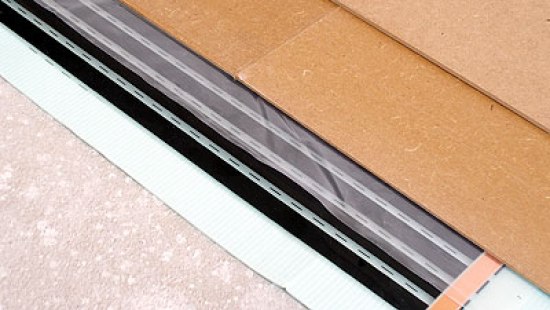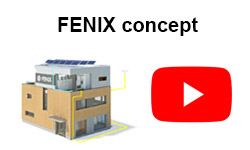HEAT-PAK floor boards for the placement of floor heating under a carpet and PVC

Today, floor heating is gradually coming to be considered standard equipment, and not only as a system intended for heating but also as a comfortable accessory for the household. Almost everyone has heard about the pleasant feeling which warm floor tiling brings into the bathroom and most of us know at least one person who uses this comfortable heating. Because of this, only a few people ask whether it is possible to place heating mats into the cement under the tiling – it has become something which is obvious and nobody finds this application unusual. However, the situation with other floor coverings is somewhat different.
FENIX, as the producer, is often approached by customers asking whether it is possible and suitable to lay something other than floor tiling onto electric heating. Of course, it is possible and almost all producers of the individual types of floor coverings offer also a type which is suitable for use in combination with floor heating. It is usually no problem at all in the case of new applications – in the case of floor tiling, PVC and carpets, ECOFLOOR heating cables or heating mats are placed into flexible cement or self-leveling screed, while for floating floors, FENIX offers electric ECOFILM heating foils. However, the situation is worse in the case of additional installations or reconstructions. As is noted above, the comfort of a heated floor is not so unusual these days and when reconstructing a flat or house, why not treat oneself to it?
However, it is sometimes not easy. It happens often that customers approach us asking for advice. They would be interested in floor heating in a room and they would like to have a carpet or PVC as the final layer. They don't want ceramic floor tiles and don't take floating floors into consideration. The use of a wet process – i.e. with various floor screeds and cements - is not an option for various reasons. Mostly, their interest then focuses directly on ECOFILM heating foils which they consider ideal – installation is a dry process, the foil is very thin and it heats throughout its whole surface. But even ECOFILM foils cannot be laid directly under a carpet or PVC in a standard way. They are, after all, a heating element for a voltage of 230 V and these coverings don't provide sufficient protection. What is more, there is a possible danger of sliding or creasing of the carpet or PVC if you move heavier objects around on them – e.g. an armchair or a sofa.
Because of this, FENIX has included to their range – HEAT-PAK floor boards. These are special underlays on the basis of compressed cellulose, imported by FENIX from Holland. The boards have a high bulk weight (770 kg/m³), so they are very hard: their strength in flexure is > 40 kg/cm², and they have good thermal conductivity (therm. resistance R = 0.047 m² * K/W). These boards combined with ECOFILM heating foils, as a dry installation system, are specifically intended for use in reconstruction and subsequent installation of floor heating under a carpet or PVC.
Recommended method of installation
Thanks to their good thermal conductivity HEAT-PAK boards can be placed between ECOFILM heating foil and a carpet/PVC without having any notably negative effect on the conveyance of heat into the room. The boards themselves are sold in paks containing 2 thicknesses – 3 and 4 mm – which are placed on top of one another. The boards are given a layer of glue in the factory, and after assembly form a solid 7 mm thick construction which offers heating foil the protection it needs against damage and yet is so hard and firm that it is possible to lay carpet and PVC directly onto it.
- Floor covering – Carpet or PVC
- 7 mm HEAT-PAK – double-layered structure glued with staggered joints (underlay 3 mm, overlay 4 mm)
- Vapor barrier – min. of 0.20 mm thick PE foil
- Ecofilm 80 W/m² (60 W/m², 40 W/m²) heating foil
- Floor insulation from extruded polystyrene (of thickness min. 3 mm)
- Original floor
The method of laying is as follows:
Place the thermal insulation upon the existing floor. It also protects the foil against the effects of any unevenness of the base. ECOFILM heating foil with a max. output of 80 W/m² is then laid onto the thermal insulation. Then, cut grooves in the insulation for the supply leads and lay 0.20 mm thick PE foil on top of the heating foil. PE foil acts as additional electrical insulation and simultaneously protects the heating foil against any possible dampness. Now, lay the HEAT-PAK boards in two layers. The first, lower layer is the 3 mm thick board, and then the upper 4 mm layer is glued onto it. The upper layer must be staggered so that it covers the joints in the lower layer, and vice versa – by doing this you are avoiding the possibility that the joints will show through the carpet or PVC, and at the same time the whole area joins together to form one combined whole. The temperature probe, which will regulate the temperature of the floor, is placed into a groove cut under the heating film.
The laying of all layers is very simple, and if you use ECOFILM Sets, you won't need any special tools at all except a sharp knife and a rubber mallet. One can use the knife to shorten the thermal insulation insulation, the PE foil and the HEAT-PAK boards. By tapping on the upper row of HEAT-PAK boards with the rubber mallet during laying one can achieve the perfect adhesion and bonding of both layers. The resultant thickness of the whole structure (thermal insulation, ECOFILM, PE foil and HEAT-PAK together) is only 10 mm! Then, you can either glue your carpet or PVC to the boards as a final layer or simply lay it freely upon them.
Testing of the warm up dynamics
Because FENIX places great emphasis on the quality of the products which they offer their customers, they always test them thoroughly before putting them on sale. HEAT-PAK boards are no exception and they were tested in a test chamber in order to discover how, and with what dynamics heat spreads within the construction in combination with ECOFILM heating foils. The tests were conducted in order to confirm the good thermal conductivity of HEAT-PAK boards and to remove the possibility that the heating foil might overheat. ECOFILM foil itself can resist 90°C, which is impossible to reach in any possible case with an output of 80 W/m². However, if the HEAT-PAK boards did not have the declared level of thermal conductivity, unwanted loss of heat into the base floor would take place and as a result, a noticeable worsening in the economical and operational parameters of the system would occur.
The first tests to be carried out were stress tests, where the whole construction with the heating foil was operated without any regulation. The aim was to determine the warm-up dynamics and the maximum temperature which can be reached.
The whole test took place at a room temperature of approx. 24 °C; this temperature was maintained with the aid of air conditioning. It is noticeable from the graph that the initial warm-up was rather dynamic, but then the higher thermal resistance of the carpet came into effect and the difference between the temperatures of the individual layers began to increase. After nine hours of operation the temperatures stabilized – at 32.7 °C for the carpet and 36.2 °C for the surface of the heating foil within the construction. It is also possible to see the good thermal conductivity of the HEAT-PAK underlay here – even at the maximum temperatures the difference between the temperature of the heating foil's surface and the surface of the HEAT-PAK underlay was a mere 1.6 °C.
In the next test the temperature probe of a thermostat was placed within the heated floor, and this maintained the temperature at 27 °C. For the first three hours the floor with the HEAT-PAK boards was operated without the final floor-covering layer, and then a carpet was placed upon the floor – in the graph the temperature on the surface of the carpet is expressed by the green curve.
We chose to use a carpet deliberately, because it has a higher thermal resistance than PVC and thus can be taken as the "worse" variant from the heat-conveyance perspective. It is clear from the graph that for the floor without a carpet the difference between the temperature on the heating foil and on the surface of the HEAT-PAK boards is less than 1 °C. The dynamics are also very good, with the floor warming up from 24 °C to 27 °C in less than 20 minutes – this is the same as in the first test. Once again, the good thermal conductivity of HEAT-PAK boards was confirmed.
The probe of the thermostat, which was set at 27 °C, was placed on the surface of the HEAT-PAK boards. It is visible on the graph that HEAT-PAK boards have a certain thermal inertia, which is a result of the larger bulk of the material. As a result, when the heating foil was cycled the temperature of the HEAT-PAK boards was more stable. After being covered by a carpet, their surface temperature increased on average by around 0.5 °C, while the difference between the foil and the HEAT-PAK boards remained within a 1 °C limit and the temperature on the surface of the carpet was only 0.5 °C lower than on the surface of the HEAT-PAK boards.
The tests which were carried out demonstrated the suitability of this construction for the application of floor heating below carpets and PVC. FENIX can thus offer such a technical solution to customers who are considering floor heating below carpets and PVC, and at the same time cannot, or do not wish to "concrete over" their new floor.








